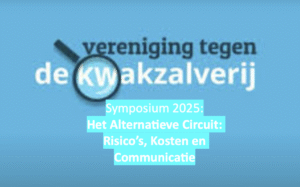A total disaster for homeopathy
Between 1936 and 1939 Germany tried to prove the efficacy of homeopathy. An enormous operation was planned, but it ended in disaster. The efforts were cut short by the war. Fritz Donner, a homeopathic physician, was one of the many people involved in these efforts. After his retirement in 1961 he wrote a report on the affair. This report was ready in 1966, but not until 1995 did it first appear in German in a little-read journal. Now it is on the internet.
of the Donner papers, the papers themselves and a short
biography of Donner. This article is an English version
of a similar Dutch article.
Fritz Donner (1896-1979) was both the son of a homeopathic physician and a homeopath himself. From 1927 on, he worked in the homeopathic hospital of Stuttgart. There he discovered that many things were seriously wrong in homeopathy.
When a homeopath prescribes a medicine, he does this by comparing the symptoms of the patient with what are called in homeopathy drug pictures. A drug picture is basically a list of symptoms related to the homeopathic drug. Homeopathic doctrine says that such a list should be composed of all the remarkable ‘symptoms’ observed in healthy people who have taken the drug. These symptoms are obtained by so-called provings (another homeopathic term). During a proving several healthy people take the drug, and then write down their ‘symptoms’ in a diary. More details can be found on Wikipedia.
Homeopathic drugs are famous for often being highly diluted, but for a proving it is not necessary to work with highly diluted materials. However, homeopathic doctrine says that the more spiritual symptoms are obtained with higher dilutions. So for potency C6 (that’s homeopathic jargon for a 100 x 100 x 100 x 100 x 100 x 100 dilution, prepared by repeatedly hitting the bottle against a soft leather object like a book binding at each dilution step), the drug picture might be different from C1, and at C30 one may have an altogether different drug picture. For example, common table salt becomes a powerful drug at high dilutions.
Delirium tremens
At least, that was (and is) the theory. Donner soon discovered that things were totally different in practice. For example, it was dogmatically assumed that Apis mellifica presented as key symptoms: (1) a small pouch under the right eyelid and (2) a lack of thirst. When Donner looked this up it turned out that these remarkable symptoms did not come from a proper drug proving, but from a case of a bee sting near the right corner of the mouth. The victim’s right cheek had swollen to gigantic proportions. While this edema was forming, the victim became very thirsty, which is quite natural when a large amount of bodily fluid all goes to the cheek. As soon as the edema subsided, the victim’s thirst vanished.
Similarly, a friend of Donner discovered that in the original writings of Hahnemann (the founder of homeopathy) there were reports of no fewer than 716 symptoms obtained by rubbing people with a magnet! It was clear (in 1927) that these must have been placebo symptoms, and Donner and his friends (all assistant physicians in the Stuttgart hospital) wondered whether other provings might not have yielded placebo symptoms as well. However, no homeopath had ever asked that question before.
One remedy, Platina, had special properties, but these all went back to precisely one instance of a ‘slightly exalted’ lady who suddenly started to see everything smaller after taking it. Such a phenomenon may have had a psychiatric cause.
Lac caninum (dog’s milk) used to be recommended strongly for diphtheria. Again this was based on one single case, namely that of Laura Morgan, a 24-year-old American lady physician. On one summer morning in 1870 she took a few grains CM (a dilution prepared by a special recipe of the American Dr. Swan) of this remedy, and subsequently she suffered for two years from frequently recurring bouts of delirium tremens. According to homeopathic doctrine it doesn’t matter at all what people suffer from before they take the remedy. During these two years Laura once had a sore throat. This was diagnosed as diphtheria, but Donner thought this diagnosis should not be trusted. In the first place Laura apparently wasn’t sick enough to stay in bed, and in the second place US physicians often had very poor training then. Sometimes one could become fully licensed after a study of two years, or even one year, without seeing any patients at all, and with only elementary school knowledge as a prerequisite.
Donner was very surprised that nobody wanted to listen to his findings about the unreliability of drug pictures. Moreover, when he gave a talk on the Lac caninum affair, his superiors threatened to fire him on the spot if he ever pulled off a similar stunt again.
Completely unblinded
In 1927 Germany was greatly interested in homeopathy. A famous surgeon named August Bier (inventor of the spinal-puncture method of anaesthesia) had pleaded in favour of homeopathy in 1925. The State Health Organisation (Reichsgesundheitsamt, RGA), an organisation comparable to the FDA and the NIH rolled into one, decided that homeopathy should be tested. In 1933 the Nazis came into power in Germany. Apart from their unsavoury politics, they were also quite obsessed with health and natural medicine. Not many people know that German medical doctors figured out well before 1945 that smoking was the main cause of lung cancer, long before Doll and Peto did the same. So in 1936, during an International Homeopathic Congress in Berlin, it was solemnly announced (by Rudolf Hess!) that tests were going to be started.
The gentlemen of the RGA worked with German thoroughness. First they interviewed many homeopaths about their views and practices. Donner relates that they visited him 300 times. The plan was to first perform provings (randomized double blind, of course) and later also tests of homeopathic remedies on patients. If everything worked out, the German state was prepared to spend hundreds of millions of (pre-war) dollars.
It soon turned out that traditionally a so-called proving never was performed in a blinded fashion. Sometimes the testees were given a bottle with a placebo to begin with, but then they were told: ‘This is a placebo to test your suggestibility’! No wonder everybody left his diary blank after that. When Donner got the idea to omit this warning, and even went as far as to give everybody three rounds of placebo (in three successive weeks), his testees, physicians who took his introductory course in homeopathy, filled their diaries with just as many ‘symptoms’ as when they got a real (highly diluted) remedy.
When Donner told this to his homeopathic colleagues, they didn’t believe him. ‘This is humanly impossible!’ they said. Around the same time, Paul Martini was performing similar experiments, as part of the same mega-project, and he was criticized much for his findings. It was also discovered that in reprovings (provings to confirm the findings of ancient homeopaths) the leaders of the experiments were wont to select from the diaries those symptoms they thought to be confirmatory, ignoring all the many, many others.
Not many experiments with treatments of sick people were performed. However, the chairman of the Central Association of Homeopathic Physicians in Germany, Hanns Rabe, conducted one, under the supervision of the RGA. He was allowed to select a number of chronic hospital patients who could be treated well with the Silicea remedy (highly diluted sand). Donner warned him that these patients would not recover, and they didn’t. It was such a debacle that the gentlemen of the RGA did not dare to report this to their superiors. Maybe they feared dismissal or worse when the political leaders would hear that their beloved therapy had failed so dismally. Then Rabe was pressured by the RGA to plan an experiment to cure Basedow’s disease by homeopathy. He had bragged that this was easy, and he even had signed written statements to that effect, so he couldn’t refuse.
That was the moment that Rabe confessed to Donner that homeopathy couldn’t do that at all, that homeopathy was merely psychotherapy in disguise and all this bragging by homeopaths should not be taken literally. Donner did not agree at first, but later changed his opinion at least partly, after he had discovered to what degree his own treatments were merely placebo treatments, that worked purely because of the belief of the patients – who often had imaginary diseases as well.
In the three years between 1936 and 1939 many more experiments could have been performed, but from Donner’s letters it appears that it was quite common that homeopaths bragged a lot, but when they were called upon to cooperate in clinical experiments under the supervision of the RGA, they did everything to avoid cooperation.
Incidentally, one should not think that these tests were cruel maltreatments of inmates of death camps. The teams selected for conducting experiments were high ranking staff members of academic hospitals, who were supposed to work with the patients of their hospitals. If necessary, the state was prepared to pay for extra temporary departments in the hospitals, for example a Basedow department with 50 beds for Rabe. For drug provings one thought about recruiting volunteers from lay homeopathic associations; Donner himself tested in a few years altogether about 200 doctors taking his courses.
As inoffensive as possible
After the outbreak of the war the experiments were stopped. (In fact, Reichsfüher-SS Heinrich Himmler ordered amateurish tests to be performed in concentrations camps, but these had nothing to do with the RGA tests.) However, after the war the RGA and its successor, the Federal Health Service (Bundesgesundheitsamt, BGA), were looking for a long time for someone who wanted to deal with all the collected material, an approximately 12-foot-high stack of folders with transcripts of interviews, together with the results of drug provings (and probably all the diaries of those provings). Homeopaths tend to be longwinded, so all those interviews may have constituted a sizeable portion of the material. Donner was too busy running a hospital in Berlin, so he did not want to take on the task. But after Donner’s retirement in 1961, the BGA and others kept asking him to write a report on the whole affair ‘from a homeopathic point of view’. Donner worked for four years on this, and when he surmised that a publication from the BGA was forthcoming and that the tests were to be continued, he whittled down his 300-page report to 40 pages and tried to submit this to a homeopathic journal.
It was his intention to bring sense to his homeopathic friends before it was too late. He hoped that they would abandon all their beliefs in high dilutions, and just stick to a few substances, and to drug pictures for low potencies: C1, C2 and maybe C3. Apparently he believed that the similia principle would hold true for these cases. However, the homeopathic journal refused to publish his article, and the BGA did not publish it either. The 12 feet of paperwork vanished without a trace. One would almost suspect a conspiracy, but it was probably just sloppiness and stupidity, as usual. In 1969 a translation of Donner’s report was published in a French homeopathic journal, but it did nothing to abate the rise of homeopathy. Indeed, ‘homeopathy’ has become a highly profitable over-the-counter medication, which is a far cry from doctors spending an hour with a patient, while leafing through impressive volumes to locate the ‘most similar’ drug for all the patient’s subjective complaints and experiences.
Donner also wrote two letters to homeopathic colleagues with comments on his report. He had tried to keep his report as inoffensive as possible, omitting the worst examples of homeopathic stupidity and ignorance. In his letters to trusted colleagues he was less restrained. One of them was the then chairman of the Homeopathic Association, Erich Unseld, and the other was the editor-in-chief of the main homeopathic journal, Heinz Schoeler.
Reading those letters one wonders: why did Donner not give up on homeopathy altogether? I think there are two reasons. One is that it was his childhood faith. The other is that before 1939 homeopathy and regular medicine where not as different as one might think.
Homeopaths used to boast that their hospitals had better results. Donner wrote a paper explaining that there were so many differences between homeopathic and regular hospitals that a comparison would be meaningless. He pointed also to a 1915 publication (reprinted in several American homeopathic journals) by Professor Fritz Conrad Askenstedt of the Southwestern Homoeopathic Medical College in Louisville. From April 1, 1899, the city hospital had an agreement with the College that one out of every six patients admitted to the hospital should be treated by the homeopaths of the College. Food and nursing (and presumably the anaesthetics during operations) were exactly the same for all patients, only the medication being different for the homeopathically treated patients. It turned out that the death rates of the ‘allopaths’ and the homeopaths were statistically indistinguishable. Neither was there a difference when the deaths were split according to the kind of disease (lung, heart, intestines, kidney, infectious disease, surgery, etc.). The explanation was of course that, at the time, regular medicine was pretty powerless. In a 1922 paper that compared homeopathy and regular medicine, the following regular medicines for pneumonia were listed: atropine, caffeine, camphor oil, digitalis, morphine, strychnine, whiskey, etc.
Regular medicine improved only slowly. Donner wrote to Unseld that he and his friends in Stuttgart had tried to establish the effect of homeopathy on pneumonia in 1930. At that time he observed a death rate of 55% (7 out of 13), which he thought to be unacceptably high compared to regular medicine, especially because they did not treat the more serious cases, but only patients who were perfectly healthy before the onset of pneumonia, and not, for example, old and weak people who could no longer afford to pay health insurance.
Homeopathy is based on the similia principle, and Donner’s attitude shows that belief in this principle is logically independent from belief in the efficacy of high dilutions. For most critics of homeopathy these high dilutions are the most baffling part of homeopathy, but the similia principle rests on equally poor foundations: jumping to conclusions and crediting anecdotal experiences.
Dreaming on
Reading between the lines, one gets the impression that the gentlemen of the RGA did not believe a thing about homeopathy. But the highest authorities (Hess and maybe even Hitler himself) had ordered them to prove homeopathy, and orders being orders, they could not refuse to cooperate. If they would find that homeopathy did not work, they would need cast iron proofs that they had done their utmost to be fair. They gave the homeopaths no chance to complain of unfairness. Rabe confessed to Donner that the gentlemen had been so utterly correct and amicable that he could not find any pretext to refuse cooperation, and that he was racking his brains for a way to sabotage the proceedings, ‘because we can’t do at all what we claim we can do’. And when Donner tried to explain to the RGA that all this stuff with high dilutions was nonsense, they told him in no uncertain terms that they had been charged with examining the standard practice of homeopaths, and not the opinions of one Mr. Donner.
The whole Donner report was published in German in a not very well-known journal (Perfusion) in 1995, and also in a dissertation of 2003. The letters of Donner to Unseld and Schoeler became available in French translation in the appendix of a 1985 book. Furthermore, the original German texts are now available on the internet (as well as a Dutch translation).
Many people are unaware of the shaky foundations (the drug pictures) of homeopathy. The homeopaths are unwilling to show that this basis is more than fantasy. All over the world science students start out doing simple experiments confirming well known principles. So why don’t homeopaths do the same? The basic experiments of homeopathy are so simple that a nine-year-old child could do them, just as Emily Rosa did in the case of Therapeutic Touch. In fact, one of the first randomized double blind trials in the history of medicine was a homeopathic drug proving (and it failed miserably). So let the homeopaths first show how to do simple drug provings properly blinded and randomized, if they can.
If they are not willing to do that, they apparently do not take themselves seriously enough to deserve to be taken seriously by others. Let them dream on, and invent ever more silly remedies. We shouldn’t spend a penny of public money on checking the effectiveness of homeopathy. It’s not worth it. Homeopathy is in the same category as perpetual motion machines and the flat-earth doctrine.
Newsletter
The Digital Newletter of the Dutch Association against Quackery will keep you informed regularly about new articles on this site.
Gerelateerde artikelen
RFK Jr. ontslaat vaccinatieraad
artikelen - 26 juni 2025Buitenlandrubriek met o.a.: RFK Jr. ontslaat vaccinatieraad / Drie op tien Amerikanen maakt gebruik van astrologie, tarotkaarten en toekomstvoorspellers.
Lees meerSymposium-programma 2025 bekend
artikelen - 26 juni 2025Save the date: 4 oktober zal het VtdK-sympsium plaatsvinden. Dit jaar is het thema 'Het Alternatieve Circuit: Risico’s, Kosten en Communicatie'. Hier vindt u het programma.
Lees meerEen wit-paars-groen-gele aura tegen blauwtong
artikelen - 20 juni 2025Stef Freriks straalt olijfolie in om deze bij schapen en runderen in te zetten tegen een besmetting met het blauwtongvirus, een nare ziekte.
Lees meer






